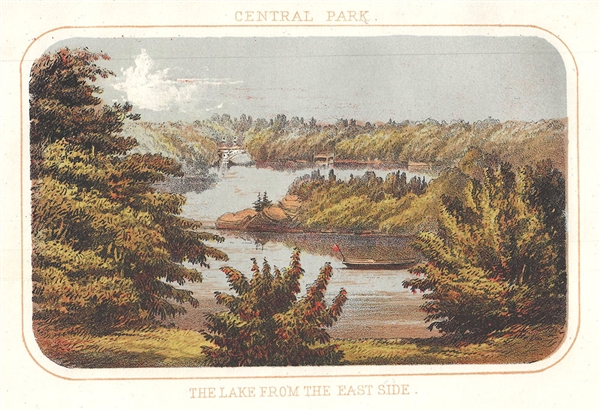
This item below is out of stock, but another example (left) is available. To view the available item, click "Details."
Details
1868 Shannon and Rogers View of the Lake, Central Park, New York City
1868 (undated) $100.00
1868 Shannon and Rogers View of the Lake, Central Park, New York City
LakeFromEastSide-shannon-1868
Title
1868 (undated) 5 x 7.5 in (12.7 x 19.05 cm)
Description
Vaux and Olmsted were awarded the task of designing Central Park in 1853 by the City Common Council. Olmsted's vision drove the overall design while Vaux concentrated his attentions on bridges, buildings, and other structures within the park. The creation of Central Park, which was to consist of some 800 acres of public forest, pathways, promenades, lakes, bridges, and meadows, was a seminal moment in civic urban design. The park itself was designed as a whole with every tree, pond, and bench meticulously planned. Olmsted wrote: 'Every foot of the parks surface, every tree and bush, as well as every arch, roadway, and walk and been placed where it is for a purpose.'
Historian Gloria Deak writes,
'There was a staggering amount of work to be done to transform the area into a blend of pastoral and woodland scenery. This involved the design and construction of roadways, tunnels, bridges, arches, stairways, fountains, benches, lamp posts, gates, fences and innumerable other artifacts. It also involved the supervision of an army of about five thousand laborers…Olmsted, to whom most of the credit goes, insisted on seeing the multidimensional project as a single work of art, which he was mandated to create. For this purpose, he ventured to assume to himself the title of 'artist'Today, because of Vaux and Olmsted's efforts, New York Yorkers, ourselves included, have the privilege of enjoying what is, perhaps, the finest example of a planned urban public recreation area in the world.
Prepared for inclusion in the 1868 edition of Joseph Shannon's Manual of The Corporation of the City of New York.
CartographerS
Joseph Shannon (fl. c. 1850 - 1869) produced a series of New York City almanacs and fact books entitled Manual of the Corporation of the City of New York. Shannon's Manual is very similar to the more common manual issued by David T. (Thomas) Valentine (1801 - 1869). The production of this annual manual was the responsibility of the Clerk of the Common Council of the City of New York, a position held at different times by both Shannon and Valentine. The manual included facts about the City of New York, City Council information, history, and reported on the progress of public works such as Central Park. More by this mapmaker...
William C. Rogers (fl. c. 1860 - 1873) was a New York based lithographer active in the mid to late 19th century. His is best known for his engravings issued in conjunction with Joseph Shannon's Manual of the Corporation fo the City of New York. Rogers issued several maps of New York City in the 1860s and 1870s. Learn More...

